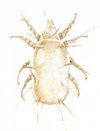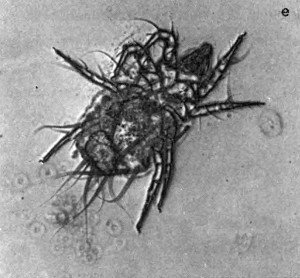
Latin: Tyrolichus casei.
Up to 0.7 mm long, whitish body with yellowish or red legs. The cheese mite is the most common of the mites that live in cheese and in places where cheese is stored. The cheese mite prefers substrates with available protein and high-fat foods. It cannot dig into cheese, but infests cheese in places where there are already cracks. This species is 15 -18 days to fully develop and is similar to the prune mite both in terms of life cycle, reproductive rate and demerits.

Cheeses in Northern Europe rarely reach old age, due to quality control, and today cheese is also protected by a tight coating. This makes the mite rarer than it used to be. In case of errors in the coating or faulty packaging, with subsequent storage in a damp room for a long time, the conditions for cheese mites are present.
On infested cheeses, brownish accumulations of dead mites, empty hides and lots of droppings can be seen. It is up to the consumers to decide whether cheese mites are tolerated or not. Modern people would probably avoid the mites, but in certain cheeses (in Germany for example) cheese mite cultures are included as seasoning. When speaking of cheeses that are so alive “that they come when you call”, it is hardly the tiny, slow and unimpressive cheese mites you think of, but rather the cheese skippers’ large and vibrant larvae




